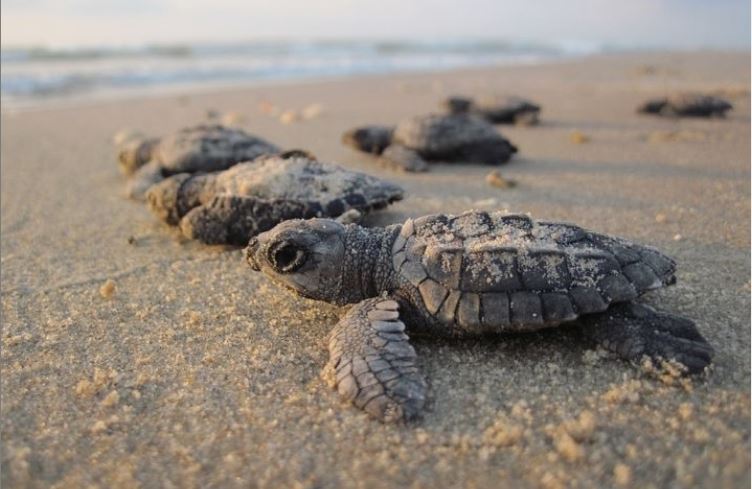Every year since 2020, Qatar has allowed residents to witness a miracle of life in its purest form.
Every summer, holders of Qatar Museums’s (QM) unique and exclusive member card, Culture Pass, are allowed to get up close to newly hatched hawksbill sea turtles during the annual hatching season at Fuwairit Beach. The annual hatching phase of the hawksbill turtle, which have been classified as an endangered species by the International Union for Conservation of Nature in 1982, takes place from the beginning of June until the end of July.
Dadu, Children’s Museum of Qatar, in collaboration with the Ministry of Environment and Climate Change (MOECC) with the support of the Qatar Natural History Group, invites Qatar Museums’ Culture Pass Family members on Turtle Encounters field trips to observe the hatching of the hawksbill turtle as part of the Qatar Turtle Project at Fuwairit Beach.
Once one of Qatar’s most popular beaches, Fuwairit Beach, has permanently closed in 2020 to protect the endangered sea turtles during the hatching season. It has become a conservation area and sanctuary for turtles and birds to live and breed.
With funding from QatarEnergy (QE), MME takes a number of steps to protect the endangered sea turtles during the hatching season. Qatar is home to three species of sea turtles, the most important of which is the hawksbill, which is of great importance to the region’s ecosystem.

MME’s Wildlife and Protection Department consists of a team of highly qualified environmental inspectors and observers to supervise the project site. The team collects data on the turtle nesting season, including date, time and distance between the nest and the edge of the water.
The project began in 2003 as part of the Environmental Science Center (ESC) at Qatar University (QU), which implemented the Qatar Turtle Project to protect Qatar’s hawksbill sea turtles. This project is one of the most important projects towards preserving Qatar’s marine life.
Throughout the years, the majority of the nesting has taken place in Fuwairit Beach. It is believed to be the most preferred location for the turtles to nest because of the nature of the beach. In addition to being quiet (as MME annually closes the beach), Fuwairit’s soft sand make it the perfect place for nesting as turtles can easily dig into the sand to lay their eggs. However, nesting and hatching has been recorded in beaches neighbouring Fuwairit in the north of Qatar including Halul, Lehwaylah, Al Jassasiya, Al Maroona, Al Ghariya and Al Mafjar. A timetable has been made to ensure the presence of researchers and other team members around the clock while nesting turtles at the beaches of Halul, Lehwaylah, Al Jassasiya, Al Maroona, Al Ghariya and Al Mafjar. At least 100 hawksbill sea turtles nest in Qatar annually.

The mating process for hawksbill sea turtles takes place every two years and the nesting process begins in late March or early April, with the females leaving the sea and looking for a suitable nesting ground.
Reproduction
Every two to five years, female hawksbills return to the beaches where they were born to nest, which normally takes place in shallow waters close to the shore.
The nesting procedure begins when the turtles leave the sea to choose an area to lay their eggs. They dig a pit in the sand, lay their eggs, and then cover it. At this stage, the turtles retreat to the sea, leaving the eggs, which will hatch in about 60 days. The eggs hatch two months after they are laid and the young turtles instinctively crawl towards the sea.
Habitat and Diet
In addition to Qatar, hawksbill sea turtles are found throughout the tropical waters of the Atlantic, Pacific and Indian Oceans. They avoid deep waters, preferring coastlines where the sponges they like to feed on are abundant, and sandy nesting sites are within reach. These highly migratory reptiles help maintain a healthy coral reef ecosystem.
Hawksbills are omnivorous and will also eat molluscs, marine algae, crustaceans, sea urchins, fish, and jellyfish. Their hard shells protect them from many predators, but they still fall prey to large fish, sharks, crocodiles, octopuses, and humans.
Threats to Survival
The hawksbill sea turtles are critically endangered for several reasons. According to National Geographic, the most dangerous time of their lives comes when hatchlings make the journey from their nests to the sea. Crabs and flocks of birds voraciously prey on the young turtles.
According to MME, the survival rate of the young hawksbill sea turtles in Qatar’s waters are 15% to 20% due to bigger fish and birds preying on the young turtles. In addition, the hatching takes place at night as preying birds pose a serious threat to the survival of the young hawksbill sea turtles during the day.
Habitat loss is also a serious threat facing hawksbill turtles. Coastal development has reduced the space available for them to nest, while rising temperatures associated with global climate change is killing the coral reefs they rely on for food.
Common name: Hawksbill sea turtles
Scientific name: Eretmochelys imbricata
Type: Reptiles
Diet: Carnivore
Average life span in the wild: 30 to 50 years
Size: 24 to 45 inches
Weight: 100 to 150 pounds
Current population trend: Decreasing – critically endangered
Author: Ola Diab
Copyright © Marhaba Information Guide. Reproduction of material from Marhaba Information Guide’s book or website without written permission is strictly prohibited. Using Marhaba Information Guide’s material without authorisation constitutes as plagiarism as well as copyright infringement.





